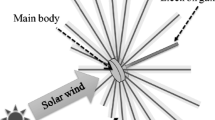Abstrac
This paper deals a Solar Bow Shock mission, a phenomenon of interaction between the solar wind and the interstellar medium, due to the relative motion of our star with respect to the enormous interstellar matter cloud that contains it. This phenomenon occurs at boundary of the solar system (200 AU), and it is preferable a mission in situ that could examine in detail what actually happens on-the-spot, to understand its effect on the planets of the solar system. Voyager 1 & 2 reached the area where the phenomenon takes place after 30 years. The target is to arrive there optimizing both the transfer time, and the propellant mass consumption. Therefore, the trajectory will be optimized using different propulsion systems and appropriate flyby sequences.. The approach techniques that will be used foresee executions of impulsive or ballistic gravity assists with the utilisation of high thrust engine only, or low thrust engine only, or both engines in two different phases of the mission. By comparing all the solutions obtained imposing different initial conditions the optimal trajectory to arrive at Solar Bow Shock is presented.
Similar content being viewed by others
References
Bertotti, B., Farinella, P., and Vokrouhlicky, D., Physics of the Solar System: Dynamics and Evolution, Space Physics, and Spacetime Structure, Dordrecht: Kluwer Academic, 2003.
Stone, E.C., Vogt, R.E., McDonald, F.B., Teegarden, B.J., Trainor, J.H., Jokipii, J.R., and Webber, W.R., Cosmic Ray Investigation for the Voyager Mission: Energetic Particles Studies in the Outer Heliosphere and Beyond, Space Sci. Rev., 1977, vol. 21, pp. 355–376.
Stone, E.C., Cummings, A.C., McDonald, F.B., Heikkila, B.C., Lal, N., and Webber, W.R., Voyager 1 Explores the Termination Shock Region and Heliosheath Beuond, Science, 2005, vol. 309, pp. 2017–2020.
Krimigis, S.M., Mitchell, D.G., Roelof, E.C., Hsieh, K.C., McComas, D.J., Imaging the Interaction of the Heliosphere with the Interstellar Medium from Saturn with Cassini, Science, vol. 326, pp. 971–973.
Lyngvi, A.E., van der Berg, M.L., and P. Falkner, Study Overview of the Interstellar Heliopause Probe, April, Noordwijk: ESA, 2007.
Holzer, T.E., Mewaldt, R.A., Neugebauer, M., The Interstellar Probe: A Frontier Mission to the Heliospheric Boundary and Interstellar Space, Proc. 22nd Intern. Cosmic Ray Conf., Dublin, Ireland, 1991.
Liewer, P.C., Mewaldt, R.A., Ayon, J.A., and Wallace, R.A., NASA’s Interstellar Probe Mission, in Space Technology and Application International Forum-2000, El-Genk, M.S., Ed., AIP Conference Proceedings CP504, New York: American Institute of Physics, 2000, p. 911.
IBEX: The Interstellar Boundary Explorer, http://ibex.swri.edu/.
Mengali, G. and Quarta, A.A., Escape from Elliptic Orbit Using Constant Radial Thrust, Journal of Guidance, Control and Dynamics, 2009, vol. 32, no. 3, pp. 1018–1022.
Quarta, A.A. and Mengali, G., Optimal Switching Strategy for Radially Accelerated Trajectories, Celestial Mechanics and Dynamical Astronomy, 2009, vol. 105, no. 4, pp. 361–377.
Circi, C., Mars and Mercury Missions Using Solar Sails and Solar Electric Propulsion, Journal of Guidance, Control, and Dynamics, 2004, vol. 27, no. 3, pp. 496–498.
Circi, C., Lunar Base for Mars Mission, Journal of Guidance, Control, and Dynamics, 2005, vol. 28, no. 2, pp. 372–374.
Bolle, A. and Circi, C., A Hybrid, Self-Adjusting Search Algorithm for Optimal Space Trajectroy Design, Adv. Space Res., 2012, vol. 50, no. 4, pp. 471–488. doi: 10.1016/j.asr.2012.04.026
Macdonald, M., McInnes, C.R., and Dachwald, B., Heliocentric Solar Sail Orbit Transfers with Locally Optimal Control Law, Journal of Spacecraft and Rockets, 2007, vol. 44, no. 1, pp. 273–276.
Macdonald, M., McInnes, C.R., and Hughes, G.W., A Near-Term Roadmap for Solar Sailing, in Proc. 55th Intern. Astronautical Congress, Vancouver, Canada, 2004, American Institute of Aeronaitics and Astronautics, p.96.
Leipold, A.L., Falkner, P., Lappas, V., Fichtner, H., Kraft, S., and Heber, B., Interstellar Heliopause Probe—Design of a Challenging Mission to 200 AU, in Proc. 2nd Intern. Symposium on Solar Sailing, New York, USA, 2010.
Quarta, A.A. and Mengali, G., Electric Sail Mission Analysis for Outer Solar System Exploration, Journal of Guidance, Control, and Dynamics, 2010, vol. 33, no. 3, pp. 740–755.
Janhunen, P., Electric Sail for Spacecraft Propulsion, Journal of Propulsion and Power, 2004, vol. 20, no. 4, pp. 763–764.
Bernhardt, S., Ehrlich, T., Evans, M., Homeier, A., Lehmann, C., Oscarsson, P., and Traub, T., HERMES (Heliosphere Research Mission Escaping the Solar System) Project, 2007.
Ariane 5: User’s Manual, July 2011, http://www.arianspace.com.
Atlas Launch System Mission Planner’s Guide, Atlas 5. December 1999, http://spacecraft.ssl.umd.edu
Petropoulus, A.E., and Longuski, J.M., Shape-Based Algorithm for Automated Design of Low-Thrust, Gravity-Assist Trajectories, Journal of Spacecraft and Rockets, 2004, vol. 41, no. 5, pp. 797–804.
McConaghy, T.T., Debban, T.G., Petropoulus, A.E., and Longuski, J.M., Design and Optimization of Low-Thrust Trajectories with Flyby, Journal of Spacecraft and Rockets, 2003, vol. 40, no. 3, pp. 380–387.
Okutsu, M., Yam, C.H., and Longuski, J.M., Low-Thrust Trajectories to Jupiter via Flybys from Venus, Earth and Mars, AIAA/AAS Astrodynamics Specialist Conference, Keystone, CO, August 21–24, 2006. Paper no. AIAA 2006-6745.
Deb, K., Pratap, A., Agarwal, S., and Meyarivan, T., A Fast and Elitist Multiobjective Genetic Algorithm: NSGA-II. IEEE, Transactions on Evolutionary Computation, 2002, vol. 6, no. 2.
Hager, W.W., Stabilized Sequential Quadratic Programming, Computational Optimization and Applications-Special Issue on Computational Optimization—A Tribute to Olvi Mangasarian, Part I, 1999, vol.12, issue 1–3, pp.253–273.
Author information
Authors and Affiliations
Corresponding author
Additional information
The article is published in the original.
Rights and permissions
About this article
Cite this article
Pizzurro, S., Circi, C. Optimal trajectories for solar bow shock mission. Cosmic Res 50, 459–465 (2012). https://doi.org/10.1134/S0010952512060056
Received:
Published:
Issue Date:
DOI: https://doi.org/10.1134/S0010952512060056




